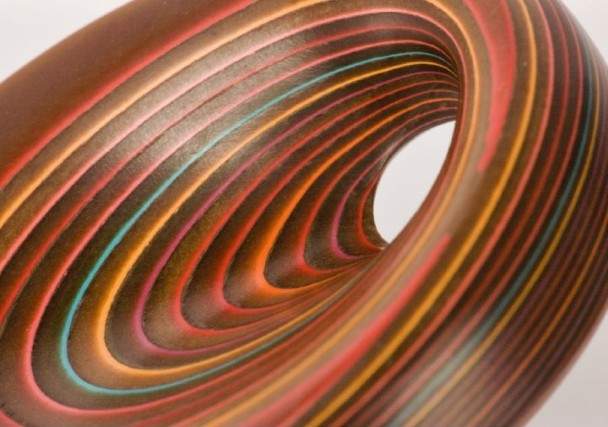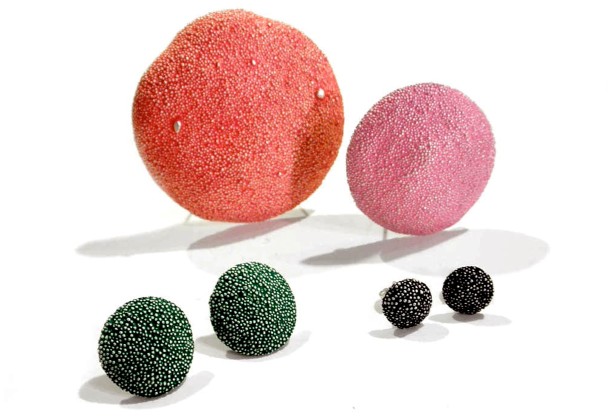Sydney’s Unique Jewellers
Sydney is home to incredibly creative contemporary jewellers. Concrete Playground went to Gaffa to find out more about them.
Peering into the display cases at Sterling, the contemporary jewellery store in private gallery Gaffa, it's hard to believe manager Amy Robson and co-manager Nina Baker when they say that contemporary jewellery isn't necessarily about the materials used.
The doubt isn't there because they don't know their stuff – a quick chat with Baker and Robson reveals an impressive depth of knowledge that can only stem from their involvement with and passion for contemporary jewellery – but because of the vast array of materials being used in such creative ways around the room: Majella Beck replaces gemstones on brooches with swirly-patterned bouncy balls; Liesl Hazelton braids and fashions electrical wires into colourful rings; Vanessa Williams's twisted strips of elegantly-coloured titanium form angular earrings and bracelets. As Baker clarifies, "Contemporary jewellery should be described as artists working in the medium of jewellery: it's the ideas and stories behind the processes which are important; it's not just making a beautiful product to be bought and sold."
The beauty of the jewellery in Gaffa goes far beyond the aesthetic, with each piece showcasing the brilliance of the jeweller behind it. Take, for example, the brooches in Mark Vaarwerk's Crayon Series, with silver textures that protrude from vividly-coloured forms. "They're silver, with crayon wax melted in," explains Baker. "He gets the beady texture from making a mould out of shrunken-down Styrofoam cups."
This latter technique, among others, is the signature of a remarkable jeweller. Melting down domestic plastics such as shampoo bottles and Styrofoam cups, Vaarwek makes a mould, which is then shrunken down to emphasise its unique texture by bringing down to a domestic scale a process normally only possible on an industrial scale. It's innovation like this which demonstrates great control over the materials Vaarwerk works with.
A willingness to experiment beyond a material's perceived limits is integral to the world of contemporary jewellery. The work of Kristy-Lee Agresta uses Laminex, a plastic normally reserved for the surfaces of bench tops. Instead of using its surface, however, Agresta uses the edge of Laminex to create layers conveying line and colour. Her work is instantly recognisable by the exactness of the lines and the machine-like precision of its smooth edges and surfaces. "Of course, these are all handmade," Baker says, on this last trait; each piece in Agresta's collection is put together layer by layer.
Initially from Griffith, Agresta was selected for an emerging artist residency at Square Peg Studios in Newtown and moved to Sydney to take it up. Once there, she was able to meet more people in the jewellery community and develop a range of contemporary jewellery that was ready to go into shops. Agresta's work has received awards and has also been featured in travelling exhibitions and, while hard work and innovation were necessary for this recognition, so too was becoming a part of Sydney's contemporary jewellery community.
Becoming a part of the jewellery community is a process made easy by the communal studios offered by Square Peg and Gaffa. Communities start off practically, with artists looking for such studios to share expensive jeweller's tools and large pieces of equipment, the purchasing and storage of which normally aren't viable on their own. "But they're not on their own," Baker corrects. "They're in this healthy, encouraging, creative bubble, and that's great. They can pick the minds of those around them and get feedback on their own work. They can travel together to conferences and exhibitions and meet a lot of people. Studios like this play a huge role in creating and strengthening the jewellery community at large – locally, nationally, and internationally."
While Square Peg Studios specialises in providing artists with a space in which they can refine technique and art, Gaffa is something of a peculiar beast. Housed in the three-storey CBD building is a retail arcade, a jewellery and object store, a cafe, an art gallery, and artist studios. Having all of these things, however, works to the advantage of its resident jewellers, with exposure to the different types of people that enter the building. Overall, Gaffa helps artists develop professionally."I graduated from university with zilch: no tools, no office, and no business structure," says Baker, herself a resident jeweller at Gaffa. "I applied for a space at Gaffa, and, all of a sudden, if a client wanted me to make a ring for them, they could drop by my studio in this big building on Clarence Street and have a coffee. It gave me this air of professionalism that artists often find difficult to access."
For Helen Mok, a recent graduate of the Sydney College of the Arts, becoming a part of the Gaffa community has been invaluable. Mok, an intern at Gaffa, has recently had an exhibition, Experiment, in Gaffa's Failspace, and will be a feature artist in Sterling's Curio Collector's Cabinet, dedicated to showcasing artists and their practice.
Currently on display in Sterling is Mok's handcrafted Secret Garden range. The detailing is extraordinary, as if she'd cast real flowers and twigs in silver and shrunk them into wearable pieces, although this wasn't the process at all. "I drew inspiration from nature," Mok says. "But I was inspired by the imagination of childhood as well, so I carved these [imaginary plants] out of wax. They're make-believe."
Carving moulds from wax is an ancient technique, and it's exactly this craftsmanship which customers of Gaffa and clients of its artists seek in contemporary jewellery. "People who come through here think outside the box," explains Baker. "They don't want a piece that you can buy from Prouds or Tiffany & Co. They want something that they can care about – they want a piece connected to the history of an ancient craft, connected to the artist who made it; they want a piece that they can wear and start a conversation with, not just because it's attention-grabbing, but because it says something as well."
So, if ever you notice an interesting bit of contemporary jewellery, whether pinned to someone's lapel or sitting in a glass display, don't be afraid to ask about the story behind it. As Baker says, "Once you start to talk about it, so much more is revealed."
Gaffa is located at 281 Clarence Street, Sydney, and on 30 June will be hosting Creative Lane, an art and craft festival celebrating local artists and their handmade goods. All images from Gaffa.








